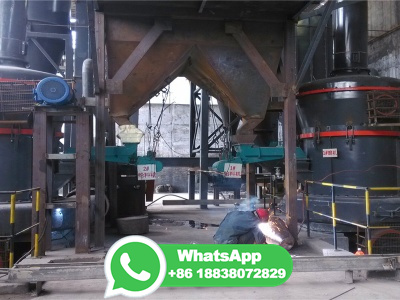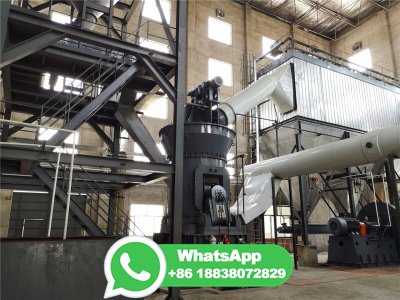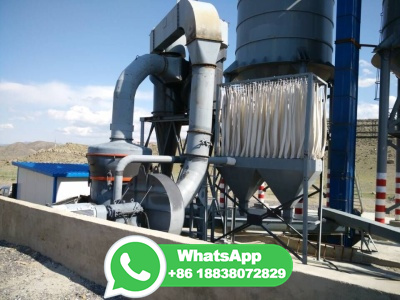
WEBMay 8, 2013 · Iron ore is commonly chemically reduced by carbon in a blast furnace at 1,600 °C to give liquid iron that is saturated with carbon, and a mixture of CO 2 and carbon monoxide 3. The carbon ...
WhatsApp: +86 18203695377
WEBFeb 8, 2020 · The iron ore industries of India are expected to bring new technologies to er to the need of the tremendous increase in demand for quality ores for steel making. With the highgrade ores depleting very fast, the focus is on the beneficiation of lowgrade resources. However, most of these ores do not respond well to the conventional .
WhatsApp: +86 18203695377
WEBJun 1, 2012 · The results indi ed that iron nugget making process depends mainly on heating time and temperature. And the iron nugget and slag can separate in a clean manner at 1673 K for 15 min. For the iron nugget, the C content is 3. 57% (mass percent) and B is 0. 065% (mass percent). The B203 content of slag is %, and the boron .
WhatsApp: +86 18203695377
WEBJun 4, 2024 · A new process could offer a solution to reducing carbon emissions in iron and steelmaking. BioIron™ uses raw biomass and microwave energy instead of coal to convert Pilbara iron ore to iron and has the potential to support low carbon dioxide (CO2) steelmaking. Our modelling shows that when combined with renewable energy and .
WhatsApp: +86 18203695377
WEBMay 1, 2014 · The ITmk3 process uses lowgrade iron ore 3 and coal (other feedstocks can be used as supplements) to produce iron nuggets whose quality is superior to that of DRI (97 percent iron content) but is similar to that of pig iron. The mixing, agglomeration, and feeding steps are the same as in the production of DRI or BFs, but the RHF is .
WhatsApp: +86 18203695377
WEBJan 24, 2024 · A colleague suggested the duo try the process with red mud. It wasn't a sure thing, because the chemistry of red mud is much more complex than iron ore. But after melting 15 grams of the mud inside a furnace for about 10 minutes, the researchers found pearlsize spheres of nearly pure iron. "I was quite surprised," Souza Filho says.
WhatsApp: +86 18203695377
WEBNov 26, 2014 · Pelletizing of iron ore was started in the 1950s to facilitate the utilization of finely ground iron ore concentrates in steel production. For the pelletizing of iron ore there are two main types of processes namely, the straight travelling grate (STG) process and the grate kiln (GK) process. In the STG process, a stationary bed of pellets is ...
WhatsApp: +86 18203695377
WEBJun 28, 2013 · HIsarna process is a smelting reduction process for producing liquid iron directly from iron ore fines and coal. It represents a new, potentially more efficient way of making iron and is being developed for substantial reduction of carbon emissions from the ironmaking process. It is an initiative of ULCOS (ultra low carbon dioxide steelmaking ...
WhatsApp: +86 18203695377
WEBSteelmaking. Steelmaking is the process of producing steel from iron ore and/or scrap. In steelmaking, impurities such as nitrogen, silicon, phosphorus, sulfur and excess carbon (the most important impurity) are removed from the sourced iron, and alloying elements such as manganese, nickel, chromium, carbon and vanadium are added to produce ...
WhatsApp: +86 18203695377
WEBIron Making . When iron is being made ore, coke and stone are introduced through the top of the blast furnace at regular intervals. ... During the steelmaking process, these elements, which make steel brittle, must be removed. In the process of steelmaking, the hot metal, along with some scrap, is fed into a refractorylined vessel ("converter ...
WhatsApp: +86 18203695377
WEBTaconite (/ ˈ t æ k ən aɪ t /) is a variety of banded iron formation, an ironbearing (over 15% iron) sedimentary rock, in which the iron minerals are interlayered with quartz, chert, or name taconyte was coined by Horace Vaughn Winchell (1865–1923) – son of Newton Horace Winchell, the Minnesota state geologist – during their pioneering .
WhatsApp: +86 18203695377
WEBJun 4, 2024 · The iron ore beneficiation process aims to remove impurities and enhance the iron content in the ore, making it suitable for use in steel production. ... The beneficiation of various types of iron ore is a complex process that requires careful analysis and planning. Whether it is hematite, magnetite, or any other iron ore, .
WhatsApp: +86 18203695377
WEBNov 4, 2019 · All steel is made using raw iron. As previously mentioned, steel is characterized by the presence of iron and carbon. The ratio of these two elements varies depending on the specific type of steel being made. With that said, most types of steel contain about 1% carbon and 97% iron, with the remaining 2% consisting of trace .
WhatsApp: +86 18203695377
WEBJan 1, 2014 · The chemical reactions between iron ore (iron oxides) and reductant (coke and other injected fuels, and hydrogen from water vapor) and combustion of fuels fulfill the two important requirements of ironmaking process: reduction of iron oxides to metallic iron and forming liquid slag and hot metal; heating up the ferrous burden and coke to the ...
WhatsApp: +86 18203695377
WEBOct 9, 2023 · The Circored process uses pure H 2 to reduce iron ore with a particle size less than 1 mm, and the reduction rate of iron ore powder for 15 min at 650 °C can reach 70%. To improve the efficiency of the entire production process, 4 h H 2 reduction of iron ore powder from CFB is needed to achieve a metallization rate of 95%.
WhatsApp: +86 18203695377
WEBJul 1, 2021 · Iron and steelmaking is the largest single industrial CO 2 emitter, accounting for % of all CO 2 emissions on the planet. This fact challenges the current technologies to achieve carbonlean steel production and to align with the requirement of a drastic reduction of 80% in all CO 2 emissions by around 2050. Thus, alternative reduction .
WhatsApp: +86 18203695377
WEBDec 1, 2023 · Usually, Iron Ore is manufactured and converted into Pellets. These are oval lumps of iron ore that are hardened using fuel. This process of converting iron ore into pellets is known as Pelletization. Iron Ore Pellets are then used in the production of steel. Pellets are usually preferred instead of raw Iron Ore because it allows for maximum ...
WhatsApp: +86 18203695377
WEBApr 5, 2022 · During the process of iron ore pelletization and preparation of feed for DRI or reduction smelting processes, around 3% of pellet fines (less than 8 mm) are generated as undesired product in the existing pellet plants. Such pellet fines acquire more than 24 million tonnes generated all over the world. Recycling and reuse of these high grade ...
WhatsApp: +86 18203695377
WEBJun 10, 2020 · Iron is extracted in the form of metallic iron (Fe) by reducing the oxide ores with a reducing agent. The principal agents commonly employed to serve this reduction process are the naturally occurring forms of carbon such as coke, charcoal and coal. In order to extract the iron, Fe (55–60%)rich ore is usually used.
WhatsApp: +86 18203695377
WEBIron metallurgy in Africa developed within Africa; though initially assumed to be of external origin, this assumption has been rendered untenable; archaeological evidence has increasingly supported an indigenous origin. Some recent studies date the inception of iron metallurgy in Africa between 3000 BCE and 2500 BCE. Archaeometallurgical scientific .
WhatsApp: +86 18203695377
WEBThe Direct Reduction of Iron. Thomas Battle, ... James McClelland, in Treatise on Process Metallurgy: Industrial Processes, 2014. Agglomeration of Iron Ore. The three major forms of iron used in ironmaking are pellets, lump, and sinter. The major change in the past 50 years has been the development of costeffective pelletization technology allowing .
WhatsApp: +86 18203695377
WEBSep 1, 2023 · What Is the Process of Manufacturing Iron Ore Pellets? Pellets are formed using a method called Pellitizing. In this method, finely powdered grains of iron ore are converted into balls. These balls usually have a proportion (8mm to 20mm) that is strictly adhered to during the manufacturing process.
WhatsApp: +86 18203695377
WEBIron is the most widely used metal on Earth. Iron is used to make steel . In turn, steel is used to make buildings, bridges, railroad tracks, vehicles of all kinds, and countless other products.
WhatsApp: +86 18203695377
WEBJan 1, 2015 · The pelletization process is the primary consumer of binders in the iron ore industry. The selection of an appropriate binder type and dosage is of critical importance in producing good quality pellets at a reasonable price. Binders accomplish two very important functions in iron ore pelletization: .
WhatsApp: +86 18203695377
WEBJul 26, 2019 · As the industrial revolution developed, so did the iron industry. A set of innovations, from different materials to new techniques, allowed iron production to expand greatly. In 1709, Darby became the first man to smelt iron with coke (which is made from heating coal). Although this was a key date, the impact was limited — as the iron was ...
WhatsApp: +86 18203695377
WEBFeb 15, 2023 · It is easy to extract iron from this kind of haematite by using gravity separation and magnetic separation. Mediumgrained hematite refers to iron ore with an embedded particle size between and 2mm. This type of hematite is also relatively easy to select, mainly using gravity separation, magnetic separation and magnetic roasting.
WhatsApp: +86 18203695377
WEBFeb 16, 2017 · The sintering process, depicted in Figure 1, involves the appliion of heat to fine iron ore particles, transforming them into coarser grains [16]. Firstly, various raw materials, including iron ...
WhatsApp: +86 18203695377
WEBJul 20, 2023 · Hematite has an iron content of 70%, making it the most commercially valuable iron ore. It is typically mined from deposits that are loed close to the Earth's surface and are relatively easy to process, making it a popular choice for iron production.
WhatsApp: +86 18203695377
WEBAug 26, 2021 · Iron Making: Smelting. The blast furnace was where the smelting process was started. In 1646, the original blast furnace roared to life, lit with a 3000 degree fire that was kept burning 24 hours a day for months at a time. The blast furnace is where bog ore was smelted to create cast iron "pig" bars, so named because liquid cast iron was fed ...
WhatsApp: +86 18203695377
WEBThe molten iron from the bottom of the furnace can be used as cast iron. Cast iron is very runny when it is molten and doesn't shrink much when it solidifies. It is therefore ideal for making castings – hence its name. However, it is very impure, containing about 4% by weight of carbon. This carbon makes it very hard, but also very brittle.
WhatsApp: +86 18203695377
WEBOct 17, 2018 · The influence of gangue compositions (mainly composed of SiO2, CaO, MgO and Al2O3) on the reduction kinetics of carbonbearing iron ore pellets was estimated at 1373–1473 K in N2 atmosphere. The ...
WhatsApp: +86 18203695377